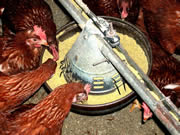DAVIS -- The
University of California’s statewide Sustainable Agriculture Research and
Education Program (SAREP) has submitted results of a two separate organic
studies to the federal government to help resolve controversies within the
rapidly growing organic food industry.
Whether
organic livestock and poultry should be fed exclusively with certified organic feeds was
at the heart of a national controversy that was resolved last month when
the U.S. Congress reinstated funding for enforcement of the organic feed
requirement.
Last fall, UC Davis-based SAREP conducted a survey among
organic producers in order to evaluate claims concerning the supply and price of
organic feed crops. The survey found that although the West is not now a major
source of organic feed, the potential is there.
SAREP is one of several
contractors nationwide that provided the U.S. Department of Agriculture (USDA)
with data on these feed crops to resolve questions about their availability.
SAREP director Sean L. Swezey and UC postgraduate researcher Samuel Prentice
conducted the survey, which is intended to help USDA make decisions about
organic regulations. The USDA is reviewing SAREP’s feed grain study before
sending it to Congress this month (June).
Organic feed crop production
in the western United States is unique in that an extensive semi-arid climate
restricts the cultivation of corn and soy, the two main animal feed ingredients
nationwide. However, the results of SAREP’s survey indicate that certified
organic land in the Western Region appears to be increasing, with feed crops
representing an increasing proportion of this land.
“In 2001, over half
of all organic acreage was planted to at least one of 10 crops identified for
their potential use in feed recipes,” said Swezey. “Interestingly, lesser-used
feed crops such as flax, millet, safflower, and dried pulses appear to be
gaining ground as feed ingredients.”
The survey results also reveal
extensive areas of land (70,000 unsprayed acres) available for rapid transition
to certified organic production. Finally, organic producers expect a premium for
their products, and several cited a rough formula of conventional price plus 20
percent as a benchmark for what they expect to be paid for organic
grains.
“National organic product sales are currently approaching
$13 billion annually, and farmers are demanding increased technical and research
services,” said Swezey. “Organic products are among the fastest growing segments
of the national food economy.”
In a separate project, UC Davis-based
SAREP also completed eight reviews of substances used in organic production for
another USDA organic initiative.
Prentice and Swezey conducted Technical
Advisory Panel (TAP) reviews, which are used by the National Organic
Standards Board (NOSB) to determine the compatibility of substances petitioned
for use in organic agriculture. The review process was set up to address
ambiguity in the national standards, and is considered integral to maintaining
the intent of the national list of substances that can and cannot be used in
certified organic systems.
“With the help of TAP reviews, the NOSB can
better interpret the letter and spirit of organic law,” said Swezey. “At the
same time, their decisions will help certifiers understand what substances a
grower may use, and what substances do not belong in a certified organic system.
Farmers will find that going directly to the materials section of the NOSB
regulations will make it easier for them to select inputs.”
SAREP has
been conducting TAP reviews since spring 2002, including reviews of Chilean
nitrate (for agriculture and aquaculture), calcium stearate,
1,4-dimethylnapthalene, and potassium sulfate. The NOSB used the reviews to
rule on use of these five materials prior to implementation of the USDA
standards last October. More recently, reviews of potassium silicate,
tetrahydrofurfuryl alcohol (THFA), and Sumisorb 300 were sent to the NOSB for
consideration at the May NOSB meeting in Austin, Tex. The NOSB’s recommendations
to the USDA will be posted at http://www.ams.usda.gov/nop/TodaysNews.html.

Click for hi-res feeding chicken image.
Media contact:
Sean Swezey, director of
University of California’s Sustainable Agriculture Research and Education
Program (SAREP), (530) 752-2379, findit@cats.ucsc.edu.


